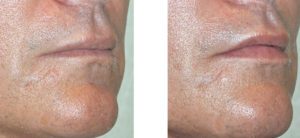The labiomental crease is the horizontal indentation between the lower lip and the chin. In most people it lies at about one-third the distance between the two. It can be very distinct and deep in some while in others it is almost non-existant. It represents the boundary between the horizontally oriented orbicularis oris muscle and the vertically oriented mentalis muscle. These two diametrically moving muscles may well account for why this crease area exists.
When the labiomental crease is deep, some may request treatment of it. A deep crease may make the chin look artificially larger or make this part of the face lok older. This is a simple area to improve with any of the commercially-available injectable fillers. The longer lasting they are the better. It can take a fair amount of volume to make a difference here, usually at least 0.5ccs or more.

Because of the location of the labiomental crease, there is no bone-based approaches that will work. In fact, chin augmentations in some patients with a deep labiomental crease will worsen its appearance by actually making it ‘deeper’ as the chin tissues come forward.
Dr. Barry Eppley
Indianapolis, Indiana


